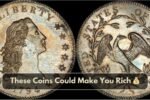Have you ever looked closely at a coin and spotted something odd? Maybe a missing date, a weird shape, or even two sides that look the same? Believe it or not, those “mistakes” can turn an ordinary coin into a treasure! Some coin minting errors are so rare, they’ve become legendary — and super valuable. Let’s dive into the top coin minting errors that didn’t just surprise collectors, but actually changed history.
What Are Coin Minting Errors?
Before we talk about the most famous ones, let’s clear up what a minting error actually is. Coins are made in large factories called mints. Sometimes, something goes wrong during the process — a misprint, a missing detail, or even a major design mix-up. These mistakes are called minting errors.
Most errors are spotted and destroyed. But once in a while, a few sneak through. When collectors get their hands on them, they can be worth a small fortune!
The 1943 Copper Penny
Imagine this: during World War II, the U.S. needed copper for bullets and war tools. So, the Mint stopped making pennies from copper and used steel instead. But somehow, a few copper blanks (that’s what the blank coin pieces are called) from 1942 got left behind.
Those blanks accidentally got stamped with 1943 designs. Just like that, the rare and famous 1943 copper penny was born.
Why is it important?
Only a handful of these pennies exist, making them extremely valuable. One even sold for over $1 million! It also shows how a tiny slip during war-time production became a collector’s dream.
The 1955 Double Die Lincoln Cent
Ever seen something printed twice on a coin? That’s what happened with the 1955 Double Die Penny. The minting press somehow shifted during the stamping process, making the words and date appear doubled.
It’s like seeing double without the eye strain!
Why does it matter?
This error is one of the most well-known and popular among coin collectors. Even beginners search for it. It made people look more closely at their change — and kicked off a new wave of interest in coin collecting.
The 2004 Wisconsin Extra Leaf Quarter
Now here’s a funny one. In 2004, the U.S. Mint released quarters for each state. When it was Wisconsin’s turn, something odd showed up. Some quarters had an extra leaf on the corn husk. Not just one kind — there were two types: one with a high leaf and one with a low leaf.
Here’s a quick look:
Type Description
Normal Corn with no extra leaf
Extra High Leaf Leaf appears high on the stalk
Extra Low Leaf Leaf appears low near the base
Why is it famous?
Nobody knows how the extra leaves got there. Was it a mistake, or did someone at the Mint do it on purpose? Either way, these quirky coins became hot items. Some sold for hundreds of dollars.
The 2007 “Godless” Presidential Dollar
In 2007, the U.S. Mint launched a new series of Presidential $1 coins. These coins had edge lettering with the words “In God We Trust” and other important details. But — oops! — some coins were printed without any edge lettering at all.
People called them the “Godless Dollars.”
Why did it matter?
Leaving out “In God We Trust” caused a lot of buzz. People were shocked and even thought it was a political message. But it was just a minting mistake. Still, it drew huge media attention and made that version of the coin highly collectible.
Conclusion
It’s amazing how simple minting errors can turn pocket change into priceless treasures. These four historic mistakes — the 1943 copper penny, 1955 double die penny, 2004 Wisconsin extra leaf quarter, and the 2007 “Godless” dollar — didn’t just catch people’s eyes. They made headlines, stirred up collectors, and even got people talking about what’s printed on their money.
So next time you get some change, take a good look. Who knows? You might be holding a piece of history.
FAQs
What is the rarest minting error?
The 1943 copper penny is one of the rarest and most valuable minting errors in U.S. history.
Are coin errors worth money?
Yes! Some errors can be worth thousands — or even millions — depending on rarity and condition.
How can I spot a coin error?
Look for odd things: double images, missing words, or strange shapes. A magnifying glass can help!
Is a mint error the same as damage?
No. Errors happen during the minting process. Damage happens after the coin is used.
Where can I sell error coins?
You can try local coin shops, online auctions, or collector forums — just be sure to get your coin appraised first!





